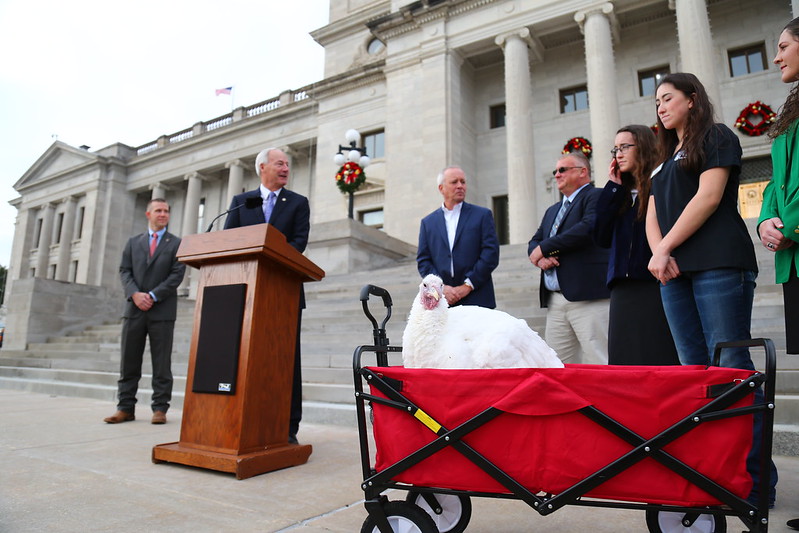Nov. 6, 2020
Turkey production falls, prices rise as pandemic continues to affect American lives, agriculture
By Ryan McGeeney
U of A System Division of Agriculture
Fast Facts:
- U.S. turkey production falls 1.5 percent from 2019
- Average wholesale price for frozen turkeys up 18 percent
- Retail turkey up about 10 percent
(663 words)
(Newsrooms: With additional file art from the 2018 Arkansas Turkey Week proclamation
at https://flic.kr/p/2d2foP4.)
(Download this story in MS Word format here.)
FAYETTEVILLE, Ark. — As the COVID-19 pandemic continues toward the third peak of new cases in the United States, even the most stalwart of family holiday gatherings, Thanksgiving, will likely be affected. Beyond complications of holiday travel, social distancing and general health concerns, there remains the perennial question: What’s a good bird cost these days?
John Anderson, an economist for the University of Arkansas System Division of Agriculture and the Dale Bumpers College of Agricultural, Food and Life Sciences, said the answer is, apparently, “a bit more than it did last year.”
In his analysis of the U.S. Department of Agriculture’s October Livestock, Dairy and Poultry Outlook report, Anderson said 2020 turkey production is down about 1.5 percent from 2019.
“Like everything else, the turkey market has been significantly disrupted by this year’s unprecedented events,” Anderson said. “This decline is largely driven by a sharp drop in second quarter production coinciding with the processing plant disruptions associated with the COVID pandemic.”
Second quarter production in 2020 is estimated to be down nearly 6 percent from 2019, according to the USDA report.
“The year-to-date decline in turkey production shows up as smaller stocks of frozen turkeys in cold storage,” Anderson said. He said the October Cold Storage Report, also published by the USDA, reflected a 12 percent lower supply of frozen turkeys — both toms and hens — than were available one year ago, with stocks falling 4 percent in September alone.
“Part of this may also be a positive demand side effect,” he said. “Turkey is more of an at-home food than beef and chicken. It may well be that turkey sandwiches made at home were a frequent substitute for fast food burgers and chicken sandwiches while food service outlets were closed.”
Anderson’s analysis of U.S. turkey production can be found online. It is part of an ongoing examination of how the COVID-19 pandemic is affecting various aspects of the agricultural economy in the country.
Given that unusual market support, both wholesale and retail turkey prices have been higher throughout most of 2020. The average wholesale price of frozen turkeys in the 16-24 lb. range was 18 percent higher this October than a year ago. Retail prices were also about 10 percent higher, with national retail prices averaging 99 cents a pound.
“It is worth noting that 99 cents per pound is still a really inexpensive protein,” Anderson said. “Retailers typically feature turkey aggressively as a special promotional item at this time of year. Customers who come into the store for a really cheap turkey will also probably pick up their sweet potatoes, cranberries, corn, green beans, etc. while they are there. It’s a great marketing strategy that pretty much every store deploys during the holiday season.”
Anderson said he believes that will also be the case for the 2020 holiday season, although things are off to “a bit of a slow start.”
According to the most recent retail activity report from the USDA, about 2,500 stores nationwide reported featuring turkey in their end-of-October sale promotions. During the same week last year, about 8,500 stores featured turkey in their advertisements. Anderson said the “turkey featuring” activity will pick up steam as Thanksgiving draws near.
Since most Americans haven’t purchased Thanksgiving turkeys yet, “most consumers will still get the benefit of these sale prices,” he said.
Despite the elevated prices, Anderson said Americans still have much to be thankful for, especially in the realm of high-quality agriculture production.
“There is no doubt that 2020 has been a challenging year for everyone,” he said. “Despite the challenges, safe and high-quality food has remained consistently available in an almost unimaginable variety at remarkably affordable prices.
“Most Americans will be able to enjoy a special holiday meal that would have been considered a wildly unattainable luxury by most people throughout human history,” he said. “With all that has gone on this year, that is something worth pausing to give thanks for.”
To learn more about extension and research programs in Arkansas, visit https://uada.edu/. Follow us on Twitter at @AgInArk, @uaex_edu or @ArkAgResearch.
About the Division of Agriculture
The University of Arkansas System Division of Agriculture’s mission is to strengthen agriculture, communities, and families by connecting trusted research to the adoption of best practices. Through the Agricultural Experiment Station and the Cooperative Extension Service, the Division of Agriculture conducts research and extension work within the nation’s historic land grant education system.
The Division of Agriculture is one of 20 entities within the University of Arkansas System. It has offices in all 75 counties in Arkansas and faculty on five system campuses.
Pursuant to 7 CFR § 15.3, the University of Arkansas System Division of Agriculture offers all its Extension and Research programs and services (including employment) without regard to race, color, sex, national origin, religion, age, disability, marital or veteran status, genetic information, sexual preference, pregnancy or any other legally protected status, and is an equal opportunity institution.
# # #
Media contact:
Ryan McGeeney
Communications Services
University of Arkansas System Division of Agriculture
Cooperative Extension Service
(501) 671-2120
rmcgeeney@uada.edu
